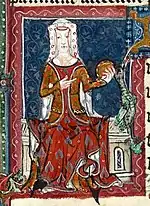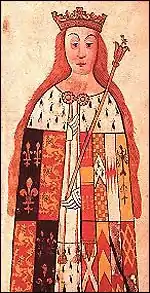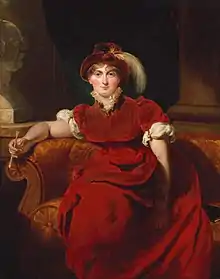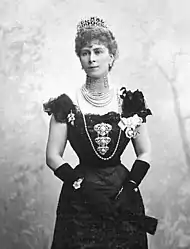| Duchess of Cornwall | |
|---|---|
| Style | Her Royal Highness |
| Member of | British royal family |
| First holder | Joan of Kent |
Duchess of Cornwall is a title held by the wife of the heir apparent to the British throne. The duchess of Cornwall usually also holds the title of Princess of Wales, and goes by that title. Queen Camilla instead went by the duchess of Cornwall title, before her husband became king. The current title-holder is the duke of Cornwall's wife, Catherine, since September 8, when King Charles III succeeded his mother and his son Prince William became duke (and later, Prince of Wales).[1]
Duchesses of Cornwall
| Person | Name | Birth | Marriage | Became Duchess of Cornwall | Spouse | Change in style | Death | |
|---|---|---|---|---|---|---|---|---|
 |
Joan of Kent | 19 September 1328 | 10 October 1361 | Edward of Woodstock | 7 June 1376 Husband's death; became Dowager Duchess of Cornwall |
7 August 1385 | ||
 |
Anne Neville | 11 June 1456 | 13 December 1470 | Edward of Westminster | 4 May 1471 Husband's death; became Dowager Duchess of Cornwall; later became Queen Consort as the wife of Richard III |
16 March 1485 | ||
 |
Catherine of Aragon | 16 December 1485 | 14 November 1501 | Arthur Tudor | 2 April 1502 Husband's death; became Dowager Duchess of Cornwall; later became Queen Consort as the wife of Henry VIII |
7 January 1536 | ||
 |
Wilhelmina Charlotte Caroline of Brandenburg-Ansbach | 1 March 1683 | 22 August 1705 | 1 August 1714 | George Augustus | 11 June 1727 Husband acceded to throne as George II; became Queen Consort |
20 November 1737 | |
 |
Augusta of Saxe-Gotha-Altenburg | 30 November 1719 | 17 April 1736 | Frederick Louis | 31 March 1751 Husband's death; became Dowager Duchess of Cornwall |
8 February 1772 | ||
 |
Caroline Amelia Elizabeth of Brunswick-Wolfenbüttel | 17 May 1768 | 8 April 1795 | George Augustus Frederick | 29 January 1820 Husband acceded to throne as George IV; became Queen Consort |
7 August 1821 | ||
 |
Alexandra Caroline Marie Charlotte Louise Julia of Denmark | 1 December 1844 | 10 March 1863 | Albert Edward | 22 January 1901 Husband acceded to throne as Edward VII; became Queen Consort |
20 November 1925 | ||
 |
Victoria Mary Augusta Louise Olga Pauline Claudine Agnes of Teck | 26 May 1867 | 6 July 1893 | 22 January 1901 | George Frederick Ernest Albert | 6 May 1910 Husband acceded to throne as George V; became Queen Consort |
24 March 1953 | |
.jpg.webp) |
Diana Frances Spencer | 1 July 1961 | 29 July 1981 | Charles Philip Arthur George | 28 August 1996 Divorced; assumed the style of Diana, Princess of Wales[2] |
31 August 1997 | ||
.jpg.webp) |
Camilla Rosemary Shand | 17 July 1947 | 9 April 2005 | 8 September 2022 Husband acceded to throne as Charles III; became Queen Consort |
living | |||
.jpg.webp) |
Catherine Elizabeth Middleton | 9 January 1982 | 29 April 2011 | 8 September 2022 | William Arthur Philip Louis | Incumbent | living | |
Until her husband's accession to the throne, Camilla, the second wife of the then-prince of Wales, used the title 'Duchess of Cornwall' rather than 'Princess of Wales', as the latter was still popularly associated with Charles's first wife, Diana, who died in 1997.[3]
Literary references
- Arthurian legend depicts Cornwall with its own ducal family. Notably, King Arthur's mother, Igraine, would have been Duchess of Cornwall from her first marriage to Duke Gorlois; in some stories, the title is then passed on to their daughter, Morgan le Fay.
- Shakespeare's King Lear includes the character "Regan, Duchess of Cornwall", Lear's second daughter.
See also
References
- ↑ "House of Commons – Royal Marriage". parliament.uk. Retrieved 23 March 2019.
- ↑ The press secretary to the Queen. "DIVORCE: STATUS AND ROLE OF THE PRINCESS OF WALES". PR Newswire. Buckingham Palace. Retrieved 9 July 2015.
- ↑ "The Royal Title that Camilla and Princess Diana Shared". Harper's Bazaar. 13 November 2018. Retrieved 2 January 2019.
When she married Prince Charles, "Camilla was not popular or well liked, [though] this has changed a lot since the marriage as Camilla has taken on a lot of patronages and Charles is a lot happier," [Marlene] Koenig says. "Still, [there was] a lot of tension and anger among a certain element of the population—so it was decided that Camilla would be styled as the Duchess of Cornwall, even though, of course, she is the Princess of Wales."
03.JPG.webp)